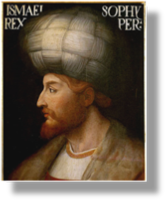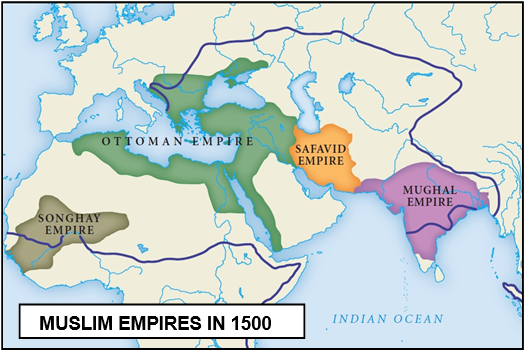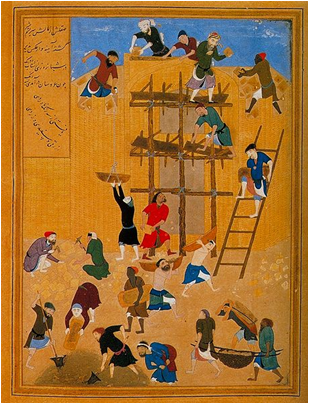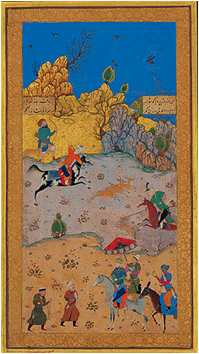


THE SAFAVID DYNASTY IS FOUNDED IN IRAN 1499 (H7)
xxxxxThe Safavids originated  as a group of Islamic mystics called the Sufis, and were named after their founder, Safi-al-Din, at the end of the thirteenth century. They became established among the nomadic tribes in north-west Iran, centred around Ardabil near the Caspian Sea and, because of their red head-dress, became known as the Kizilbash (Turkish for redheads). At one time belonging to the Muslim sect known as the Sunnites, they later became Shiite Muslims, adopting this as the religion of their people.
as a group of Islamic mystics called the Sufis, and were named after their founder, Safi-al-Din, at the end of the thirteenth century. They became established among the nomadic tribes in north-west Iran, centred around Ardabil near the Caspian Sea and, because of their red head-dress, became known as the Kizilbash (Turkish for redheads). At one time belonging to the Muslim sect known as the Sunnites, they later became Shiite Muslims, adopting this as the religion of their people.
xxxxxIn 1499 Shah Ismail I, Sheikh of Ardabil (illustrated) founded the Safavid Empire (see map), and, with the aid of his powerful Kizilbash followers, had united most of Iran under his rule by 1512, together with the Iraqi provinces of Baghdad and Mosul. The Safavids were defeated by the Ottoman Turks two years later at the Battle of Chaldiran, and they lost some of their territory, but, as we shall see, in the early part of the seventeenth century, under their leader Shah Abbas I (1623 J1), the lost land was regained from the Ottoman Turks, and Iran developed into an important trading nation. Its capital, the beautiful city of Esfahan, became a centre of artistic and architectural excellence. The dynasty finally came to an end in 1722, though technically it continued until 1736.
Ardabil (illustrated) founded the Safavid Empire (see map), and, with the aid of his powerful Kizilbash followers, had united most of Iran under his rule by 1512, together with the Iraqi provinces of Baghdad and Mosul. The Safavids were defeated by the Ottoman Turks two years later at the Battle of Chaldiran, and they lost some of their territory, but, as we shall see, in the early part of the seventeenth century, under their leader Shah Abbas I (1623 J1), the lost land was regained from the Ottoman Turks, and Iran developed into an important trading nation. Its capital, the beautiful city of Esfahan, became a centre of artistic and architectural excellence. The dynasty finally came to an end in 1722, though technically it continued until 1736.
xxxxxThe Safavids originated as a group of Islamic mystics called Sufis, named after their founder Safi-al-Din at the end of the 13th century. Centred around Ardabil near the Caspian Sea, they once belonged to the Sunnites, a Muslim sect, but later became Shiite Muslims. In 1499 the Sheikh of Ardabil, Shah Ismail I, founded the Safavid dynasty, and by 1512 he had united most of Iran under his rule. Two years later they were defeated by the Ottoman Turks at the Battle of Chaldiran, but, as we shall see, under Shah Abbas in the early 17th century (1623 J1), Iran developed into an important trading nation, and its capital Esfahan became a centre of artistic and architectural excellence. The dynasty came to an end in 1722.
Including:
Kamal al-din
Behzad

xxxxxThe talented artist Kamal al-din Behzad (c1455-c1536) was teaching at Herat at this time. He helped to maintain the skills of Persian Islamic painting and, after moving to Tabriz in 1522, made this an important centre for the arts. His work, produced between 1486 and 1495, included miniature paintings and illustrated and illuminated manuscripts, all introducing a greater degree of realism.
xxxxxTeaching and working  in Herat when Shah Ismail founded the Safavid dynasty was the talented artist Kamal al-din Behzad. (c1455-c1536). An outstanding miniaturist and art teacher, he played an important part in encouraging and maintaining the skills of Persian Islamic painting. He had been appointed head of the Herat academy some years earlier (1486) and continued to enjoy royal patronage under the new dynasty.
in Herat when Shah Ismail founded the Safavid dynasty was the talented artist Kamal al-din Behzad. (c1455-c1536). An outstanding miniaturist and art teacher, he played an important part in encouraging and maintaining the skills of Persian Islamic painting. He had been appointed head of the Herat academy some years earlier (1486) and continued to enjoy royal patronage under the new dynasty. Being admitted to the household of Tahmasp, Ismail’s son, he moved to Tabriz in 1522 and due to his guidance this city also became an important centre for the arts.
Being admitted to the household of Tahmasp, Ismail’s son, he moved to Tabriz in 1522 and due to his guidance this city also became an important centre for the arts.
xxxxxAs director of the royal library at Tabriz he was responsible for the production of the illustrated and illuminated manuscripts. Only thirty-two paintings can be attributed to him with certainty and all of these were produced between 1486 and 1495. By the example they set, these works helped to introduce a greater degree of realism into the miniature painting of his time. Illustrated here is The Construction of the Palace of Khovarnaq (above), and a hunting scene (on right).



Acknowledgements
Ismail I: 17th century portrait, artist unknown – original artwork in Uffizi Gallery, Florence. Map (Muslim Empires): from www.apkmodgame.net/tag/safavid-empire. Kamal al-din Behzad: miniature, construction of the Palace of Khovarnaq, c1494 – British Museum, London; Hunting: miniature 16th century – Golestan Palace, Tehran, Iran.
H7-1485-1509-H7-1485-1509-H7-1485-1509-H7-1485-1509-H7-1485-1509-H7-1485-1509-H7



 as a group of Islamic mystics called the Sufis, and were named after their founder, Safi-
as a group of Islamic mystics called the Sufis, and were named after their founder, Safi- Ardabil (illustrated) founded the Safavid Empire (see map), and, with the aid of his powerful Kizilbash followers, had united most of Iran under his rule by 1512, together with the Iraqi provinces of Baghdad and Mosul. The Safavids were defeated by the Ottoman Turks two years later at the Battle of Chaldiran, and they lost some of their territory, but, as we shall see, in the early part of the seventeenth century, under their leader Shah Abbas I (1623 J1), the lost land was regained from the Ottoman Turks, and Iran developed into an important trading nation. Its capital, the beautiful city of Esfahan, became a centre of artistic and architectural excellence. The dynasty finally came to an end in 1722, though technically it continued until 1736.
Ardabil (illustrated) founded the Safavid Empire (see map), and, with the aid of his powerful Kizilbash followers, had united most of Iran under his rule by 1512, together with the Iraqi provinces of Baghdad and Mosul. The Safavids were defeated by the Ottoman Turks two years later at the Battle of Chaldiran, and they lost some of their territory, but, as we shall see, in the early part of the seventeenth century, under their leader Shah Abbas I (1623 J1), the lost land was regained from the Ottoman Turks, and Iran developed into an important trading nation. Its capital, the beautiful city of Esfahan, became a centre of artistic and architectural excellence. The dynasty finally came to an end in 1722, though technically it continued until 1736.
 in Herat when Shah Ismail founded the Safavid dynasty was the talented artist Kamal al-
in Herat when Shah Ismail founded the Safavid dynasty was the talented artist Kamal al- Being admitted to the household of Tahmasp, Ismail’s son, he moved to Tabriz in 1522 and due to his guidance this city also became an important centre for the arts.
Being admitted to the household of Tahmasp, Ismail’s son, he moved to Tabriz in 1522 and due to his guidance this city also became an important centre for the arts. 

